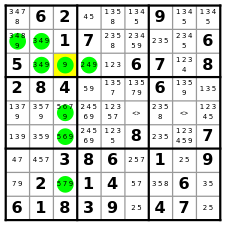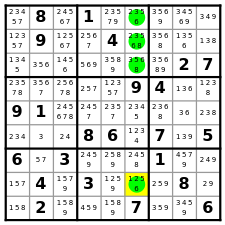Wolfram Language Paclet Repository
Community-contributed installable additions to the Wolfram Language
Single |
 |
Single-9: R2C1(3,4,8), R2C2(3,4), R3C2(3,4), R3C3(9), R3C4(2,4), R5C3(5,6,7), R6C3(5,6), R8C3(5,7) |
HiddenSingle |
 |
HiddenSingle-6: R1C6(2,3,5), R2C6(2,3,5,8), R3C6(3,5,8), R8C6(6) |
CandidateSet |
 |
CandidateSet-3: R1C7(1,5,8,9), R1C8(1,8,9), R1C9(1,5,7,9) |
CandidateSet |

CandidateSet |
 |
CandidateSet-3: R8C1(4,6,8) |
Pair |
 |
Pair-46: R4C4(2,5,7), R4C5(2,5,9), R4C6(5,9), R5C2(7,8), R5C3(7,8), R5C7(3,7,8) |
Triple |
 |
Triple-458: R4C7(1,6), R7C7(1,2,6), R9C7(1,2,6) |